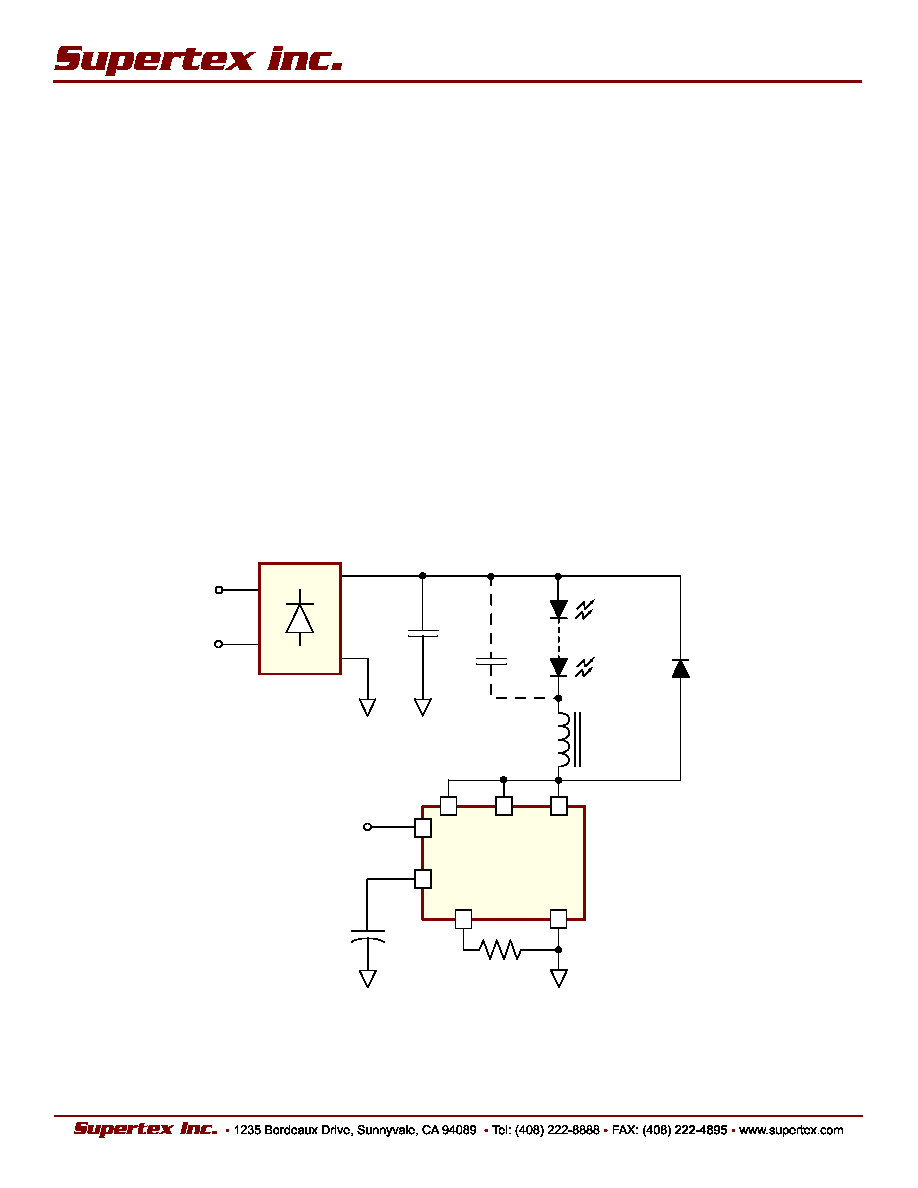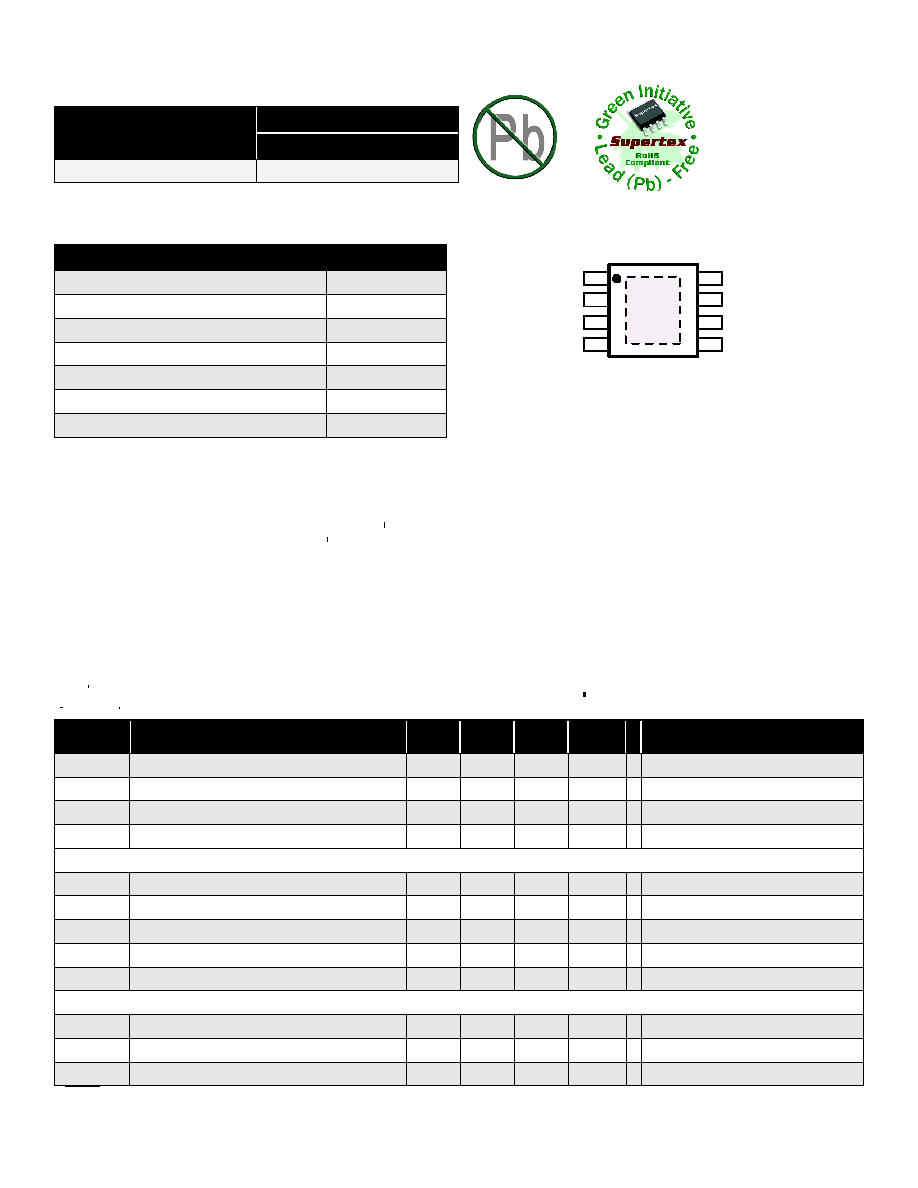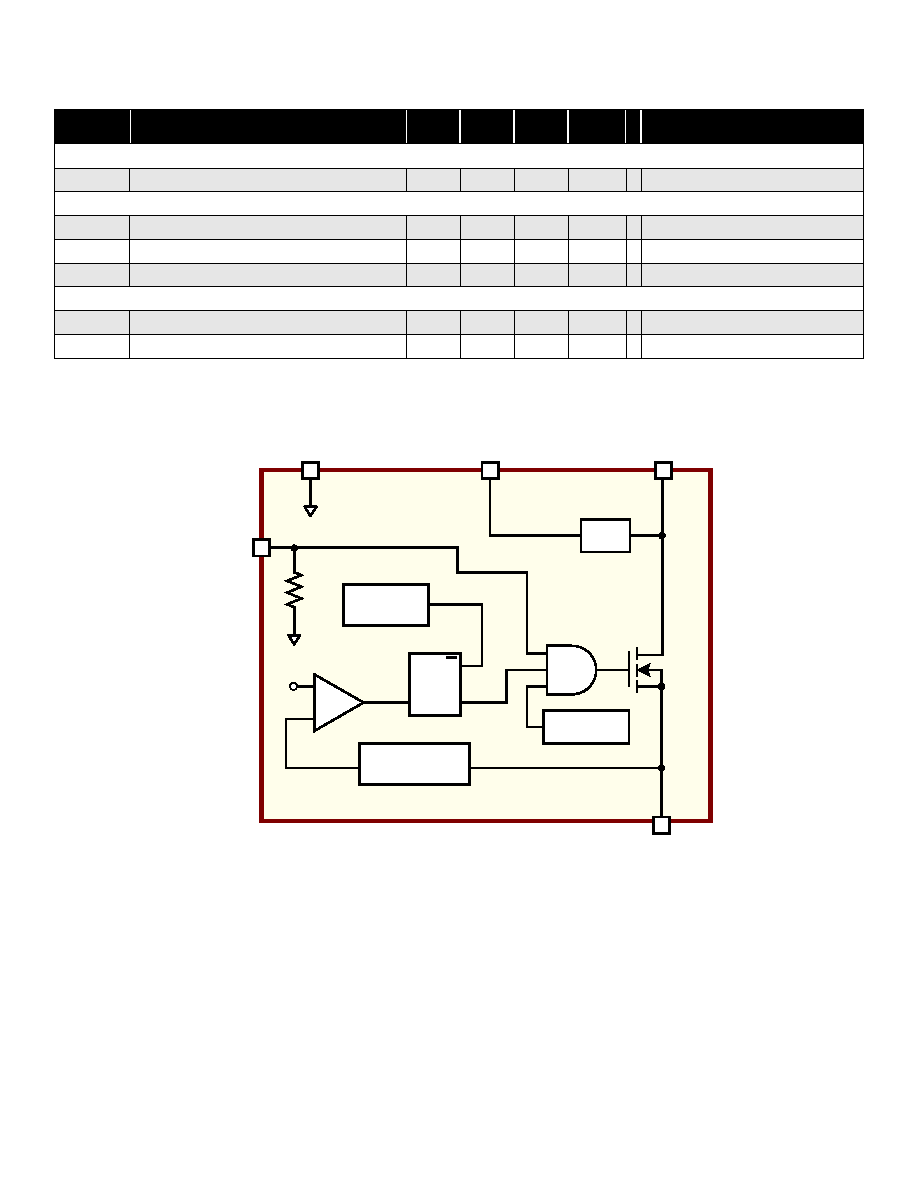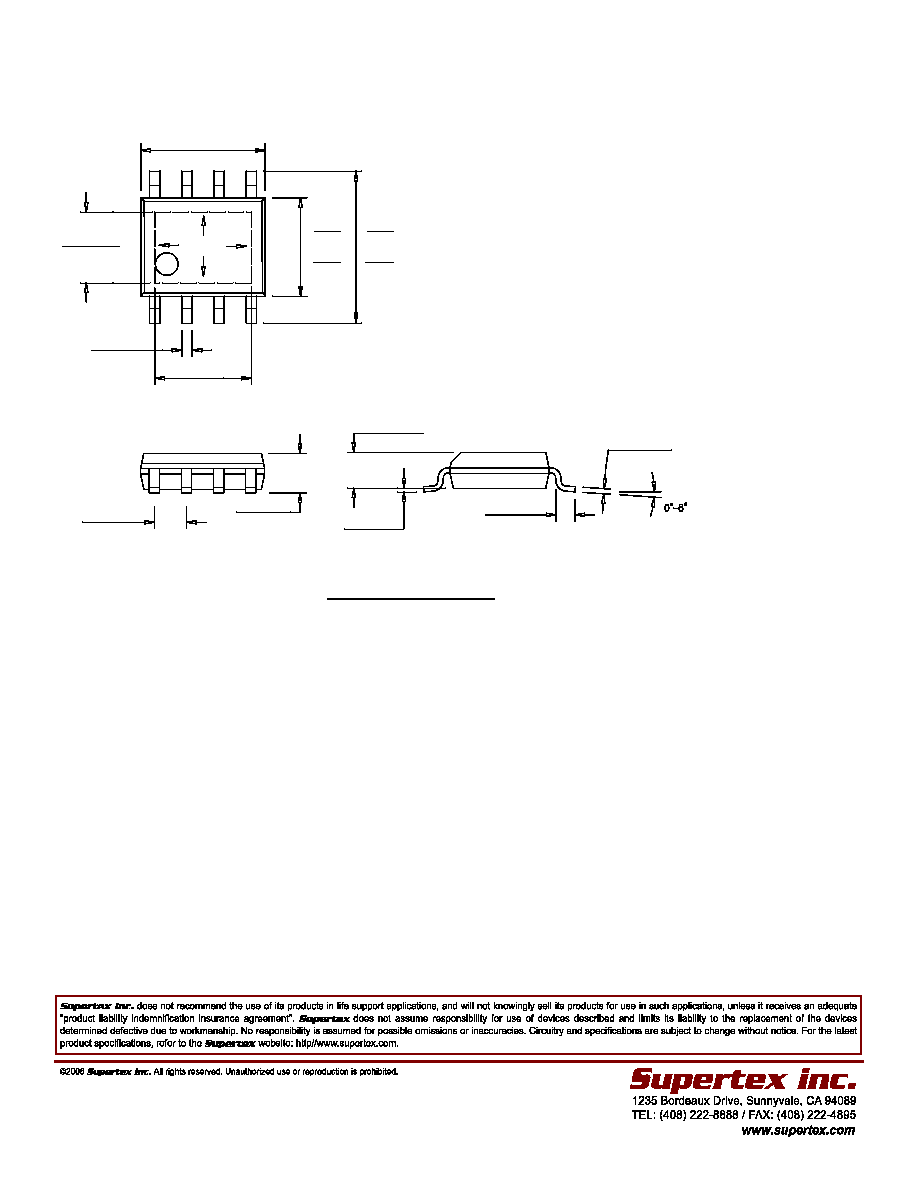 | –≠–ª–µ–∫—Ç—Ä–æ–Ω–Ω—ã–π –∫–æ–º–ø–æ–Ω–µ–Ω—Ç: HV9925 | –°–∫–∞—á–∞—Ç—å:  PDF PDF  ZIP ZIP |

1
1
NR021506
HV9925
Initial Release
Initial Release
Features
Programmable Output Current to 50mA
PWM Dimming / Enable
Universal 85-264VAC Operation
Fixed OFF-Time Buck Converter
Internal 500V Power MOSFET
Over Temperature Protection with Hysteresis
Applications
Decorative Lighting
Low Power Lighting Fixtures
General Description
The HV9925 is a pulse width modulated (PWM) high-effi ciency
LED driver control IC with PWM dimming capabilities. It
allows effi cient operation of high brightness LED strings from
voltage sources ranging up to 400VDC. The HV9925 includes
an internal high-voltage switching MOSFET controlled with a
fi xed off-time T
OFF
of approximately 10µs. The LED string is
driven at constant current, thus providing constant light output
and enhanced reliability. Selecting a value of a current sense
resistor can externally program the output LED current of the
HV9925. The peak current control scheme provides good
regulation of the output current throughout the universal AC
line voltage range of 85 to 264VAC or DC input voltage of
20 to 400V. The HV9925 is designed with a built in thermal
shutdown to prevent excessive power dissipation in the IC.
Typical Application Circuit
Programmable-Current LED Lamp Driver IC
with PWM Dimming
HV9925
U1
L1
D1
LED
1
LED
N
C
O
C
IN
C
DD
AC
~
~
BR1
8
7
6
4
3
1
2
R
SENSE
Enable
R
SENSE
GND
Drain
Drain
Drain
PWMD
V
DD

2
NR021506
HV9925
Ordering Information
DEVICE
Package Options
8-Pin SOIC w/ Heat Slug
HV9925
HV9925SG-G
-G indicates package is RoHS compliant (`Green')
Absolute Maximum Ratings*
Symbol
Parameter
Min
Typ
Max
Units
Conditions
Electrical Characteristics
(The
*
denotes the specifi cations which apply over the full operating temperature range of -40∞C < T
*
*
A
denotes the specifi cations which apply over the full operating temperature range of -40∞C < T
denotes the specifi cations which apply over the full operating temperature range of -40∞C < T < +85∞C, otherwise the specifi cations are at
T
A
T
T = 25∞C. V
DRAIN
= 25∞C. V
= 25∞C. V
= 100V, unless otherwise noted)
Parameter
Value
Supply Voltage, V
DD
-0.3 to +10V
PWMD, R
SENSE
Voltage
-0.3 to +10V
Supply Current, I
DD
+5mA
Operating Ambient Temperature Range
-40∞C to +85∞C
Operating Junction Temperature Range
-40∞C to +125∞C
Storage Temperature Range
-65∞C to +150∞C
Power Dissipation @ 25∞C
800mW**
All voltages referenced to GND pin.
**The power dissipation is given for the standard minimum pad without a
heat slug, and based on R
JA
=125∞C/W. R
JA
is the sum of the junction-to-
case and case-to-ambient thermal resistance, where the latter is deter-
mined by the user's board design. The junction-to-ambient thermal resis-
tance is R
JA
= 105∞C/W when the part is mounted on a 0.04 in
2
pad of 1 oz
2
2
copper, and R
JA
= 60∞C/W when mounted on a 1 in
2
pad of 1 oz copper.
2
2
V
DD
V
DD
regulator output
-
7.5
-
V
--
V
UVLO
V
DD
undervoltage threshold
5.0
-
-
V
--
V
UVLO
V
DD
undervoltage lockout hysteresis
-
200
-
mV
--
I
DD
Operating supply current
-
300
500
A
V
DD(EXT)
DD(EXT)
= 8.5V
Output (DRAIN)
V
BR
Breakdown voltage
500
-
-
V
* --
V
DRAIN
V
DRAIN
supply voltage
20
-
-
V
--
R
ON
ON resistance
-
100
200
I
DRAIN
= 50mA
C
DRAIN
Output capacitance
-
1.0
5.0
pF
V
DRAIN
= 400V
I
SAT
DRAIN saturation current
100
150
-
mA
--
Current Sense Comparator
V
TH
Threshold voltage
0.44
0.47
0.50
V
--
T
BLANK
Leading edge blanking delay
200
300
400
ns
* --
T
ON(MIN)
ON(MIN)
ON(MIN)
ON(MIN)
Minimum ON time
-
-
650
ns
--
Pin Confi guration
1
2
3
4
8
7
6
5
top view
SO-8 + Heat Slug
(Heat Slug Potential is at ground)
R
SENSE
GND
PWMD
V
DD
Drain
Drain
Drain
NC
HV9925SG
DRAIN (6,7,8) ≠ This is a drain terminal of the output switching
MOSFET and a linear regulator input.
V
DD
(4) ≠ This is a power supply pin for internal control circuits.
Bypass this pin with a 0.1uF low impedance capacitor.
R
SENSE
(1) ≠ This is a source terminal of the output switching
MOSFET provided for current sense resistor connection.
GND (2) ≠ This is a common connection for all circuits.
PWMD (3) ≠ This is the PWM Dimming input to the IC.

3
NR021506
HV9925
Functional Block Diagram
V
DD
0.5V
+
-
DRAIN
GND
HV9925
S
R
Q
Q
REG
R
SENSE
Over Temp.
PWMD
T
BLANK
= 300ns
T
OFF
= 10s
OFF-Time Generator
T
OFF
OFF time
8.0
10.5
13
s
--
PWM Dimming
V
PWMD,HI
PWMD input high voltage
2.0
-
-
V
* --
V
PWMD,LO
PWMD input low voltage
-
-
0.8
V
* --
R
PWMD
PWMD pull down resistance
100
200
300
k
V
PWMD
= 5V
Thermal Shutdown
T
OT
Over temperature trip limit
-
140
-
∞C
--
T
HYST
Temperature hysteresis
-
60
-
∞C
--
Electrical Characteristics (cont.)
Symbol
Parameter
Min
Typ
Max
Units
Conditions

4
NR021506
HV9925
Typical Performance Characteristics
(T
J
(T
(T = 25
J
J
O
C unless otherwise noted)
Threshold Voltage V
TH
vs Temperature T
J
ON Resistance R
ON
vs Temperature T
J
OFF Time T
OFF
vs Temperature T
J
Output Capacitance C
DRAIN
vs V
DRAIN
DRAIN Breakdown Voltage BV vs T
J
Output Characteristics I
DRAIN
vs V
DRAIN
490
500
510
520
530
540
550
560
570
580
-40
-15
10
35
60
85
110
Junction Temperature, ∞C
D
R
A
I
N
B
r
e
a
k
d
o
w
n
V
o
l
t
a
g
e
,
V
0
20
40
60
80
100
120
140
160
180
0
10
20
30
40
DRAIN Voltage, V
D
R
A
I
N
C
u
r
r
e
n
t
,
m
A
1
10
100
1000
0
10
20
30
40
DRAIN Voltage, V
D
R
A
I
N
C
a
p
a
c
i
t
a
n
c
e
,
p
F
0.460
0.465
0.470
0.475
0.480
0.485
-40
-15
10
35
60
85
110
Junction Temperature, ∞C
C
u
r
r
e
n
t
S
e
n
s
e
Thre
s
h
o
l
d
,
V
9.0
9.5
10.0
10.5
11.0
11.5
12.0
12.5
13.0
-40
-15
10
35
60
85
110
Junction Temperature, ∞C
O
F
F
T
i
m
e
,
s
40
60
80
100
120
140
160
180
200
-40
-15
10
35
60
85
110
Junction Temperature, ∞C
O
N
R
e
s
i
s
t
a
n
c
e
,
O
h
m
T
J
= 25
O
C
T
J
= 125
O
C

5
NR021506
HV9925
Functional Description
The HV9925 is a PWM peak current control IC for driving
a buck converter topology in continuous conduction mode
(CCM). The HV9925 controls the output current (rather than
output voltage) of the converter that can be programmed by
a single external resistor (R
SENSE
), for the purpose of driving a
string of light emitting diodes (LED). An external enable input
(PWMD) is provided that can be utilized for PWM dimming of
an LED string. The typical rising and falling edge transitions
of the LED current when using the PWM dimming feature of
the HV9925 are shown in Fig. 6 and Fig. 7.
When the input voltage of 20 to 400V appears at the DRAIN
pin, the internal linear regulator seeks to maintain a voltage
of 7.5VDC at the V
DD
pin. Until this voltage exceeds the
internally programmed under-voltage threshold, no output
switching occurs. When the threshold is exceeded, the
integrated high-voltage switch turns on, pulling the DRAIN
low. A 200mV hysteresis is incorporated with the under-
voltage comparator to prevent oscillation.
When the voltage at R
SENSE
exceeds 0.47V, the switch turns
off and the DRAIN output becomes high impedance. At the
same time, a one-shot circuit is activated that determines
the off-time of the switch (10µs typ.).
A "blanking" delay of 300ns is provided upon the turn-on of
the switch that prevents false triggering of the current sense
comparator due to the leading edge spike caused by circuit
parasitics.
Application Information
Selecting L1 and D1
Selecting L1 and D1
The required value of L1 is inversely proportional to the ripple
current I
O
in it. Setting the relative peak-to-peak ripple to
20~30% is a good practice to ensure noise immunity of the
current sense comparator.
(1)
V
O
is the forward voltage of the LED string. T
OFF
is the off-
time of the HV9925. The output current in the LED string (I
O
)
is calculated then as:
(2)
where V
TH
is the current sense comparator threshold, and
R
SENSE
is the current sense resistor. The ripple current
introduces a peak-to-average error in the output current
setting that needs to be accounted for. Due to the constant
off-time control technique used in the HV9925, the ripple
current is nearly independent of the input AC or DC voltage
variation. Therefore, the output current will remain unaffected
by the varying input voltage.
Adding a fi lter capacitor across the LED string can reduce
the output current ripple even further, thus permitting a
reduced value of L1. However, one must keep in mind that
the peak-to-average current error is affected by the variation
of T
OFF
. Therefore, the initial output current accuracy might
be sacrifi ced at large ripple current in L1.
Another important aspect of designing an LED driver with
HV9925 is related to certain parasitic elements of the
circuit, including distributed coil capacitance of L1, junction
capacitance, and reverse recovery of the rectifi er diode D1,
capacitance of the printed circuit board traces C
PCB
and output
capacitance C
DRAIN
of the controller itself. These parasitic
elements affect the effi ciency of the switching converter and
could potentially cause false triggering of the current sense
comparator if not properly managed. Minimizing these
parasitics is essential for effi cient and reliable operation of
HV9925.
Coil capacitance of inductors is typically provided in the
manufacturer's data books either directly or in terms of the
self-resonant frequency (SRF).
where L is the inductance value, and C
L
is the coil capacitance.
L
L
Charging and discharging this capacitance every switching
cycle causes high-current spikes in the LED string. Therefore,
connecting a small capacitor C
O
(~10nF) is recommended to
bypass these spikes.
Using an ultra-fast rectifi er diode for D1 is recommended to
achieve high effi ciency and reduce the risk of false triggering
of the current sense comparator. Using diodes with shorter
reverse recovery time t
rr
,
rr
rr
and lower junction capacitance C
J
,
achieves better performance. The reverse voltage rating V
R
of the diode must be greater than the maximum input voltage
of the LED lamp.
The total parasitic capacitance present at the DRAIN output
of the HV9925 can be calculated as:
(3)
When the switch turns on, the capacitance C
P
is discharged
into the DRAIN output of the IC. The discharge current is
limited to about 150mA typically. However, it may become
lower at increased junction temperature. The duration of the
leading edge current spike can be estimated as:
(4)
L
V T
I
O
OFF
O
1
=
I
V
R
I
O
TH
SENSE
O
=
-
1
2
SRF
L C
L
=
1 2
/(
)
C
C
C
C
C
P
DRAIN
PCB
L
J
=
+
+
+
T
V
C
I
t
SPIKE
IN
P
SAT
rr
=
+

6
NR021506
HV9925
In order to avoid false triggering of the current sense
comparator, C
P
must be minimized in accordance with the
following expression:
(5)
where T
BLANK(MIN)
is the minimum blanking time of 200ns, and
V
IN(MAX)
is the maximum instantaneous input voltage.
The typical DRAIN and R
SENSE
voltage waveforms are shown
in Fig. 3 and Fig. 4.
Estimating Power Loss
Estimating Power Loss
Discharging the parasitic capacitance C
P
into the DRAIN
output of the HV9925 is responsible for the bulk of the
switching power loss. It can be estimated using the following
equation:
(6)
where Fs is the switching frequency and I
SAT
is the saturated
DRAIN current of the HV9925. The switching loss is the
greatest at the maximum input voltage.
The switching frequency is given by the following:
(7)
where is the effi ciency of the power converter.
When the HV9925 LED driver is powered from the full-wave
rectifi ed AC input, the switching power loss can be estimated
as:
(8)
V
AC
V
V is the input AC line voltage.
The switching power loss associated with turn-off transitions
of the DRAIN output can be disregarded. Due to the large
amount of parasitic capacitance connected to this switching
node, the turn-off transition occurs essentially at zero-
voltage.
Conduction power loss in the HV9925 can be calculated as:
(9)
where D = V
O
/V
IN
is the duty ratio, R
ON
is the ON resistance,
I
DD
is the internal linear regulator current.
When the LED driver is powered from the full-wave
rectifi ed AC line input, the exact equation for calculating the
conduction loss is more cumbersome. However, it can be
estimated using the following equation:
(10)
where V
AC
where V
where V is the input AC line voltage. The coeffi cients K
C
and K
d
can be determined from the minimum duty ratio
D
m
=0.71Vo/(V
AC
=0.71Vo/(V
=0.71Vo/(V ).
Fig. 1. Conduction Loss Coeffi cients K
C
and K
d
EMI Filter
As with all off-line converters, selecting an input fi lter is critical
to obtaining good EMI. A switching side capacitor, albeit of
small value, is necessary in order to ensure low impedance
to the high frequency switching currents of the converter. As
a rule of thumb, this capacitor should be approximately 0.1-
0.2 µF/W of LED output power. A recommended input fi lter is
shown in Figure 2 for the following design example.
Design Example 1
Let us design an HV9925 LED lamp driver meeting the
following specifi cations:
Input:
Universal AC, 85-264VAC
Output Current: 20mA
Load:
String of 10 LED (LW541C by OSRAM
V
F
= 4.1V max. each)
The schematic diagram of the LED driver is shown in
Fig.2.
C
I
T
t
V
P
SAT
BLANK MIN
rr
IN MAX
<
-
(
)
(
)
(
)
P
C V
V I
t
F
SWITCH
P IN
IN SAT
rr
S
=
+
2
2
F
V
V
V
T
S
IN
O
IN
OFF
=
-
-
1
P
D I
R
I
V
D
COND
O
ON
DD
IN
=
+
-
(
)
2
1
P
K
I
R
K I
V
COND
C
O
ON
d DD
AC
=
+
2
0
0.1
0.2
0.3
0.4
0.5
0.6
0.7
0.1
0.2
0.3
0.4
0.5
0.6
0.7
Kd Dm
(
)
Kc Dm
(
)
Dm
P
T
V
C
I
t
V
V
SWITCH
OFF
AC
P
SAT
rr
AC
O
+
(
)
-
(
)
-
1
2
2
1

7
NR021506
HV9925
Step 1. Calculating L1.
The output voltage V
O
= 10
∑
V
F
41V (max.). Use equation
(1) assuming a 30% peak-to-peak ripple.
Select L1 68mH, I=30mA. Typical SRF = 170KHz. Calculate
the coil capacitance.
Step 2. Selecting D1
Usually, the reverse recovery characteristics of ultra-
fast rectifi ers at I
F
= 20~50mA are not provided in the
manufacturer's data books. The designer may want to
experiment with different diodes to achieve the best result.
Select D1 MUR160 with V
R
= 600V, t
rr
rr
rr
20ns (I
F
= 20mA, I
RR
= 100mA) and C
J
8pF (V
F
>50V).
Step 3. Calculating total parasitic capacitance using:
(3)
Step 4. Calculating the leading edge spike duration using:
(4), (5)
Step 5. Estimating power dissipation in HV9925 at 264VAC
using (8) and (10)
Let us assume that the overall effi ciency = 0.7.
Switching power loss:
Switching power loss:
Minimum duty ratio:
Minimum duty ratio:
Conduction power loss:
Conduction power loss:
Total power dissipation at V
Total power dissipation at V
AC(max)
AC(max)
Total power dissipation at V
Total power dissipation at V
Total power dissipation at V
Total power dissipation at V
:
Step 6. Selecting input capacitor C
IN
Select C
IN
ECQ-E4104KF by Panasonic (0.1µF, 400V,
Metalized Polyester Film).
Design Example 2
Let us now design a PWM-dimmable LED lamp driver using
the HV9925:
Input:
Universal AC, 85-135VAC
Output Current: 50mA
Load:
String of 12 LED (Power TOPLED
Æ
by
Æ
Æ
OSRAM, V
F
= 2.5V max. each)
The schematic diagram of the LED driver is shown in Fig.3.
We will use an aluminum electrolytic capacitor for C
IN
in order
to prevent interruptions of the LED current at zero crossings
of the input voltage. As a"rule of thumb", 2~3F per each
watt of the input power is required for C
IN
in this case.
Step 1. Calculating L1.
The output voltage V
O
= 12 ∑ V
F
= 30V (max.). Use equation
(1) assuming a 30% peak-to-peak ripple.
Select L1 22mH, I = 60mA. Typical SRF = 270KHz. Calculate
the coil capacitance.
Step 2. Selecting D1
Select D1 ES1G with V
R
= 400V, t
rr
rr
rr
35ns and C
J
< 10pF.
Step 3. Calculating total parasitic capacitance using: (3)
Step 4. Calculating the leading edge spike duration using
(4), (5)
Step 5. Estimating power dissipation in HV9925 at 135VAC
using (6), (7) and (9)
Switching power loss:
Switching power loss:
L
V
s
mA
mH
1
41 10
0 3 20
68
=
=
µ
.
C
L
SRF
mH
KHz
pF
L
=
=
1
1 2
1
68
2 170
13
2
2
(
)
(
)
C
pF
pF
pF
pF
pF
P
=
+
+
+
=
5
5
13
8
31
T
V
pF
mA
ns
ns T
SPIKE
BLANK MIN
=
+
<
264
2 31
100
20
136
(
)
P
mW
SWITCH
125
P
s
V
pF
mA
ns
V
V
SWITCH
+
(
)
-
1
2 10
264
31
2 100
20
264
41
0 7
µ
.
D
V
V
m
=
0 71 41
0 7 264
0 16
.
/( .
)
.
P
mA
A
V
mW
COND
=
(
)
+
0 25 20
210
0 63 200
264
55
2
.
.
µ
P
mW
mW
mW
TOTAL
=
+
=
125
55
180
Output Power
=
=
41 20
820
V
mA
mW
L
V
s
mA
mH
1
30
10 5
0 3 50
21
=
=
.
.
µ
C
L
SRF
mH
KHz
pF
L
=
=
1
1 2
1
22
2 270
15
2
2
(
)
(
)
T
V
pF
mA
ns
ns T
SPIKE
BLANK MIN
=
+
<
135
2 35
100
35
100
(
)
C
pF
pF
pF
pF
pF
P
=
+
+
+
=
5
5
13
8
31
F
V
V
V
s
kHz
S
=
-
=
135
2 30
0 7
135
2 10
78
/ .
µ

8
NR021506
HV9925
Minimum duty ratio:
Minimum duty ratio:
Conduction power loss:
Conduction power loss:
Total power dissipation in HV9925:
Total power dissipation in HV9925:
Step 6. Selecting input capacitor C
IN
Select C
IN
3.3µF, 250V.
Figure 3. 85-135VAC LED Lamp Driver with PWM Dimming
C
IN
AC Line
85-264V
C
DD
D1
L1
LED
1
-LED
10
D2
D3
D4
D5
C
IN2
L
IN
VRD1
F1
C
O
8
4
2
HV9925
U1
1
3
7
6
R
SENSE
Figure 2. Universal 85-264VAC LED Lamp Driver
(I
O
= 20mA, V
O
= 20mA, V
= 20mA, V = 50V) from Example 1
P
pF
V
V
mA
ns
kHz
SWITCH
=
(
)
+
(
)
35
135
135
2 100
35
78
2
P
mW
SWITCH
52
D
V
V
m
=
30
0 7 135
2
0 23
/( .
)
.
P
V
mA
V
mA
V
V
COND
=
+
-
30
50
200
0 7 85
2
0 5
85
2
30
0 7
2
(
)
.
.
.
P
mW
COND
= 217
P
mW
mW
mW
TOTAL
=
+
=
52
217
269
Output Power
=
=
30
50
1 5
V
mA
W
.
C
IN
AC Line
85-135V
C
DD
D1
L1
LED
1
-LED
12
D2
D3
D4
D5
R1
C
O
8
4
2
HV9925
U1
1
3
7
6
100~200Hz
R
SENSE

9
NR021506
HV9925
Figure 4. Switching Waveforms. CH1: V
RSENSE
, CH2: V
DRAIN
Figure 5. Switch-On Transition ≠ Leading Edge Spike.
CH1: VR
SENSE
, CH2: V
DRAIN
Figure 6. PWM Dimming ≠ Rising Edge. CH4: 10◊I
OUT
Figure 7. PWM Dimming ≠ Falling Edge. CH4: 10◊IOUT

10
Doc.# DSFP - HV9925
Doc.# DSFP - HV9925
NR021506
NR021506
HV9925
8-LEAD SMALL OUTLINE PACKAGE WITH HEAT SLUG (SG)
Dimensions in Inches
(Dimensions in Millimeters)
Measurement Legend =
0.1935 +/- 0.0035
(4.915 +/- 0.085)
0.1 +/- 0.01
(2.54 +/- 0.25)
0.0165 +/- 0.0035
(0.42 +/- 0.09)
0.14 +/- 0.01
(3.555 +/- 0.255)
0.1535
+/- 0.0035
(3.9)
(+/- 0.09)
0.236
+/- .008
(5.995)
(+/- 0.205)
0.05 +/- 0.01
(1.27 +/- 0.25)
0.0575 +/- 0.0065
(1.46 +/- 0.16)
0.055 +/- 0.005
(1.395 +/- 0.125)
0.0015 +/- .0025
(0.065 +/- 0.035)
0.033 +/- 0.017
(0.84 +/- 0.43)
0.0085 +/- 0.0015
(0.215 +/- 0.035)
Heat Slug









